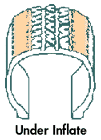|
The
radial tire revolutionized the industry
with its introduction in 1946. Today, virtually all tires
sold are radials due to their benefits
of superior handling, ride quality and
wear.
The
benefits of radial construction are
attributed to the design of the tire's
casing - the part of the tire underneath
the tread that forms the foundation of
the tire. The casing is made up of a
series of cords (most typically
polyester) which are combined to form
layers or plies. In a radial tire, these
plies are positioned so the cords run
alongside each other in a series of
circular bands across the tread of the
tire. Radial construction allows the
tire to better flex and absorb the
irregularities of the road surface. The
radial design also produces much less
friction resulting in much longer tread
life.
The top
layer of the radial casing usually
consists of steel belts made up of woven
strands of steel cord. Steel belts
provide a stable foundation for better
tread wear and traction, and also
protect the casing against impacts and
punctures. Other components may include
bead chaffers and cap plies - usually
built into performance tires to enhance
cornering and stability at high speeds.
The
outermost part of the tire, the tread,
usually attracts the most attention. The
material used is referred to as tread
compound, which varies from one tire
design to the next. A winter tire, for
example, has a compound that provides
maximum traction in cold weather.
Competition tires, at the other extreme,
use a compound designed for very high
temperature ranges. The great majority
of tires are built with an all season
compound that delivers traction in the
broad middle range of every day driving
conditions. In addition, this compound
must deliver good wear; this dual goal
of traction and wear remains one of the
most challenging design parameters for
tire manufacturers.
While
tread designs vary tremendously, the
elements of the tread are consistent in
their use. The tread block provides
traction at its leading and trailing
edge. Within the block, sipes are often
molded or cut to provide additional
traction. Grooves are built into tread
designs for channeling away water.
Shoulder designs provide protection as
well as additional traction during hard
cornering.
|
MOST COMMON TIRE WEAR
PROBLEMS
Tires often give their
owners early signs of
problems that can be
corrected. Learning how
to read these warning
signs can help extend
the life of your tires
by thousands of miles.
Here are a few of the
most common tire wear
problems.
 Wear
On Both Edges Under
Inflation Wear
On Both Edges Under
Inflation
If a tire looks like
this, it may be under
inflated. Under
inflation reduces tread
life by wearing down the
outer edges (shoulders)
of the tires. It also
reduces fuel economy of
your vehicle by
increasing the rolling
resistance. Not to
mention, the excessive
heat generated by an
under inflated tire can
reduce its durability.
The solution - check
your tires regularly for
proper inflation. If
abnormal tire wear
continues, misalignment
or mechanical problems
may be the problem.

Wear In The Center
Over Inflation
When a tire is over
inflated, the center of
the tread bears most of
the load and wears out
faster than the outside
edges. Simply check your
tire for proper
inflation. If abnormal
wear continues,
misalignment or
mechanical problems may
be the problem. The
experts at Abbsry Tire
can provide a diagnosis
and repair.

Cups Or Dips In The
Tread Worn Parts
Cupping, also called
dipping or scalloping,
is most common on the
front tires of a
vehicle. This problem
may be a sign that your
wheels are out of
balance, or that
suspension or steering
system parts are worn
out. The experts at
Abbsry
Tire can provide a
diagnosis and possible repair
solution.
Wear On One Side
Misalignment
Do the edges of the
tread take on a saw-tooth
or feathered appearance?
This is caused by
erratic scrubbing
against the road. The
solution is toe-in or
toe-out alignment
correction.

|
|
|